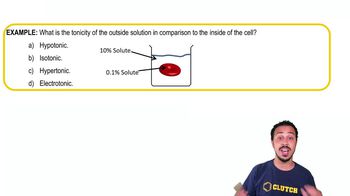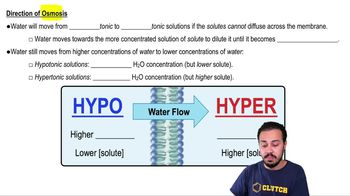Table of contents
- 1. Introduction to Biology2h 42m
- 2. Chemistry3h 40m
- 3. Water1h 26m
- 4. Biomolecules2h 23m
- 5. Cell Components2h 26m
- 6. The Membrane2h 31m
- 7. Energy and Metabolism2h 0m
- 8. Respiration2h 40m
- 9. Photosynthesis2h 49m
- 10. Cell Signaling59m
- 11. Cell Division2h 47m
- 12. Meiosis2h 0m
- 13. Mendelian Genetics4h 44m
- Introduction to Mendel's Experiments7m
- Genotype vs. Phenotype17m
- Punnett Squares13m
- Mendel's Experiments26m
- Mendel's Laws18m
- Monohybrid Crosses19m
- Test Crosses14m
- Dihybrid Crosses20m
- Punnett Square Probability26m
- Incomplete Dominance vs. Codominance20m
- Epistasis7m
- Non-Mendelian Genetics12m
- Pedigrees6m
- Autosomal Inheritance21m
- Sex-Linked Inheritance43m
- X-Inactivation9m
- 14. DNA Synthesis2h 27m
- 15. Gene Expression3h 20m
- 16. Regulation of Expression3h 31m
- Introduction to Regulation of Gene Expression13m
- Prokaryotic Gene Regulation via Operons27m
- The Lac Operon21m
- Glucose's Impact on Lac Operon25m
- The Trp Operon20m
- Review of the Lac Operon & Trp Operon11m
- Introduction to Eukaryotic Gene Regulation9m
- Eukaryotic Chromatin Modifications16m
- Eukaryotic Transcriptional Control22m
- Eukaryotic Post-Transcriptional Regulation28m
- Eukaryotic Post-Translational Regulation13m
- 17. Viruses37m
- 18. Biotechnology2h 58m
- 19. Genomics17m
- 20. Development1h 5m
- 21. Evolution3h 1m
- 22. Evolution of Populations3h 52m
- 23. Speciation1h 37m
- 24. History of Life on Earth2h 6m
- 25. Phylogeny2h 31m
- 26. Prokaryotes4h 59m
- 27. Protists1h 12m
- 28. Plants1h 22m
- 29. Fungi36m
- 30. Overview of Animals34m
- 31. Invertebrates1h 2m
- 32. Vertebrates50m
- 33. Plant Anatomy1h 3m
- 34. Vascular Plant Transport1h 2m
- 35. Soil37m
- 36. Plant Reproduction47m
- 37. Plant Sensation and Response1h 9m
- 38. Animal Form and Function1h 19m
- 39. Digestive System1h 10m
- 40. Circulatory System1h 57m
- 41. Immune System1h 12m
- 42. Osmoregulation and Excretion50m
- 43. Endocrine System1h 4m
- 44. Animal Reproduction1h 2m
- 45. Nervous System1h 55m
- 46. Sensory Systems46m
- 47. Muscle Systems23m
- 48. Ecology3h 11m
- Introduction to Ecology20m
- Biogeography14m
- Earth's Climate Patterns50m
- Introduction to Terrestrial Biomes10m
- Terrestrial Biomes: Near Equator13m
- Terrestrial Biomes: Temperate Regions10m
- Terrestrial Biomes: Northern Regions15m
- Introduction to Aquatic Biomes27m
- Freshwater Aquatic Biomes14m
- Marine Aquatic Biomes13m
- 49. Animal Behavior28m
- 50. Population Ecology3h 41m
- Introduction to Population Ecology28m
- Population Sampling Methods23m
- Life History12m
- Population Demography17m
- Factors Limiting Population Growth14m
- Introduction to Population Growth Models22m
- Linear Population Growth6m
- Exponential Population Growth29m
- Logistic Population Growth32m
- r/K Selection10m
- The Human Population22m
- 51. Community Ecology2h 46m
- Introduction to Community Ecology2m
- Introduction to Community Interactions9m
- Community Interactions: Competition (-/-)38m
- Community Interactions: Exploitation (+/-)23m
- Community Interactions: Mutualism (+/+) & Commensalism (+/0)9m
- Community Structure35m
- Community Dynamics26m
- Geographic Impact on Communities21m
- 52. Ecosystems2h 36m
- 53. Conservation Biology24m
6. The Membrane
Osmosis
Problem 6`
Textbook Question
An artificial 'cell' consisting of an aqueous solution enclosed in a selectively permeable membrane is immersed in a beaker containing a different solution, the 'environment,' as shown in the accompanying diagram. The membrane is permeable to water and to the simple sugars glucose and fructose but impermeable to the disaccharide sucrose.

a. Draw solid arrows to indicate the net movement of solutes into and/or out of the cell.
b. Is the solution outside the cell isotonic, hypotonic, or hypertonic?
c. Draw a dashed arrow to show the net osmosis, if any.
d. Will the artificial cell become more flaccid, more turgid, or stay the same?
e. Eventually, will the two solutions have the same or different solute concentrations?
 Verified step by step guidance
Verified step by step guidance1
Examine the diagram to identify the solutes present inside and outside the artificial cell. Note that the membrane is permeable to water, glucose, and fructose, but not to sucrose.
Determine the concentration gradient for each permeable solute (glucose and fructose) across the membrane. Solutes will move from areas of higher concentration to areas of lower concentration.
Draw solid arrows on the diagram to indicate the net movement of glucose and fructose based on their concentration gradients. If glucose is more concentrated inside the cell, draw an arrow pointing outwards, and vice versa for fructose.
Assess the tonicity of the solution outside the cell by comparing the total solute concentration inside and outside the cell. If the external solution has a higher solute concentration, it is hypertonic; if lower, hypotonic; if equal, isotonic.
Draw a dashed arrow to represent the net movement of water (osmosis) based on the tonicity assessment. Water will move towards the area with higher solute concentration. Determine if the cell will become more flaccid (losing water), more turgid (gaining water), or stay the same, and predict whether the solute concentrations will eventually equalize.
 Verified video answer for a similar problem:
Verified video answer for a similar problem:This video solution was recommended by our tutors as helpful for the problem above
Video duration:
4mPlay a video:
Was this helpful?
Key Concepts
Here are the essential concepts you must grasp in order to answer the question correctly.
Selective Permeability
Selective permeability refers to the ability of a membrane to allow certain molecules or ions to pass through it while blocking others. In the context of the artificial cell, the membrane permits the passage of water, glucose, and fructose but restricts sucrose, influencing the movement of solutes and water between the cell and its environment.
Recommended video:

Natural Selection
Osmosis
Osmosis is the movement of water across a selectively permeable membrane from a region of lower solute concentration to a region of higher solute concentration. This process aims to equalize solute concentrations on both sides of the membrane, affecting the cell's turgidity and the net movement of water in the artificial cell scenario.
Recommended video:
Guided course

Osmosis
Tonicity
Tonicity describes the relative concentration of solutes in two solutions separated by a membrane, determining the direction of water movement. Solutions can be isotonic, hypotonic, or hypertonic, affecting whether the artificial cell becomes more turgid, flaccid, or remains unchanged based on the solute concentration gradient between the cell and its environment.
Recommended video:
Guided course

Environmental Tonicity Affects Cells
Related Videos
Related Practice













